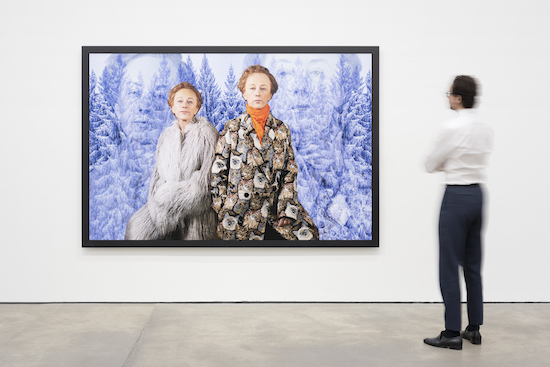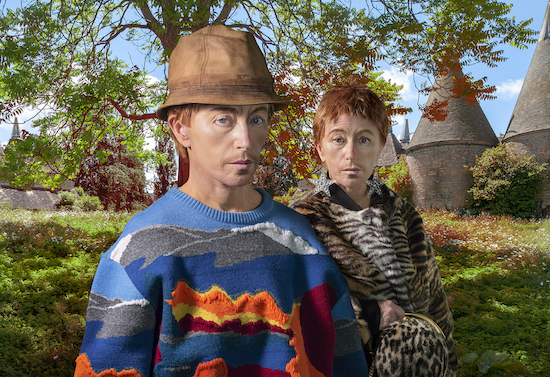Cindy Sherman, Untitle #609, 2019. © Cindy Sherman. Courtesy Sprüth Magers and Metro Pictures, New York
Is this Cindy Sherman a boy or a girl? That’s one of many questions the artist might presume the viewer asks when confronted by these carefully constructed images of mutability. We take it as a given that Sherman has a place in the history of twentieth century art. The famous fictional film stills series (made predominantly between 1977 and 1980) taps into our need for making up stories. The continuing popularity of those works reflects a persistent curiosity that begs – who is this person in the photograph? What are they up to? Someone new to these shots could be forgiven for thinking, is this taken from a movie I’ve seen before or one that I’ve missed? Is it from a movie at all? Sherman, we learn to read, is an artist pretending to be an actress, an actor.
The commentariat in the late 70s were quick to point out the sly mockery of gender roles and performativity; connections were made to the male gaze; feminist readings were the norm. This was all present and correct but what relevance has Sherman’s new work this century?
A caveat to what follows: this review is based on seeing the online images from the latest show in Berlin due to obvious circumstance. The reproductions online are clear with perhaps only scale being the limiting factor in appreciating their impact: these are photographs after all, not paintings. They are intimidatingly large in actuality – some as big as 231 by 231 cm.
I want to argue that Sherman’s moment has passed, that these new works look like a tired series with little new to offer. And what might the artist be saying? Something like: look at the people here, the couples there, you know of old that these are actually digitally manipulated pictures of me, Cindy Sherman: but does this one look male or female? Is that individual a depiction of a woman or a man?
There are ten pictures in the new show, depicting couples and some single men. Untitled #612 (all works 2019) stars Sherman as two pukka types with receding hairlines and startlingly unlined high foreheads. The man has a haughty demeanour: he’s smugly superior in his orange neck scarf, eccentrically dressed in a coat decorated with cats. The woman wears a woolly mammoth thing, earrings, lipstick. They might be Tom Wolfe and Edith Sitwell on a date. The inky blue background could be a Black Forest winter scene with its snow-covered firs.

Installation view, Sprüth Magers, Berlin, November 20, 2020–February 13, 2021, Photo: Ingo Kniest. © Cindy Sherman. Courtesy Sprüth Magers and Metro Pictures, New York
Earrings and lipstick as signifier: Sherman isn’t saying anything of stunning import, of novelty, here. In Untitled #610 the woman wears big metallic circles from her earlobes; the man a single small hoop. ‘His’ hand is on ‘her’ shoulder. Are we encouraged to read this gesture as some form of dominance, affection, or ownership? With the couple in Untitled #618 we might see a mother and her son, a dad with his tall daughter, or a gay couple of either gender. Age is implied in part by clothing. The faces we read as older frown disappointedly; those as younger have an imploring, open, trusting gaze.
The backgrounds to each of these couples seem random, fussily confusing the reading. You recognise Kent oast houses in Untitled #609 but for the life of me I can’t make any connection between these canonical signifiers that scream ‘hops’, ‘beer’, or ‘the Garden of England’ and the couple depicted. The male figure stands closest to us and wears a brown beanie hat and a bright blue and orange sweater. His partner has twin star-shaped earrings and a zebra top. Both have ginger barnets and wispy upper-lip hair. Again, the man frowns suspiciously; the more benign, gnomic, woman looks at us quizzically.
The other works feature single male figures. There’s a haughty guy in Untitled #602 looking down his nose at us in disdain; the chin seems manipulated to appear more lantern. He stands in a blurry garden wearing a t-shirt bearing a print of one of Sherman’s earlier film stills, a woman clad in a yellow shirt. Untitled #614 has a dandy equipped with perfect jawline dressed in a cape and silk strides with one hand in his pocket. He looks like a New Romantic poser. Untitled #603. sees another single male figure on a balcony overlooking an Italianate bay. Again, there’s a hint of growth on the upper lip.
Seen from an endocrine perspective we note Sherman’s references to hirsutism, unwanted hair that many women complain of. We recognise the wrinkling facial effects of hypogonadism as we all grow older, the inevitable effect of declining sex hormone levels in both ‘men’ and ‘women’: age, in James Kennaway’s words “chasing sex” – meaning gender – from our faces. In pointing this out Sherman is not exactly being revelatory.
Critics have laboured over the theme in the artist’s work, “identity as social construction”, and her pictures having a “critical stance on sexuality”, as the gallery’s own promotional video is quick to point out. But in what sense are these images ‘critical’ in the 2020s? They demand that we don’t judge people on first appearances: fine, nothing to argue with there. And, oh, androgyny is no big deal. People have been aware of this for decades – (at least) since Bowie, who made the point more entertainingly as far back as 1974. Sherman’s ideas are increasingly mainstream concepts now.
So… is this Cindy Sherman a girl or a boy? Do these pictures imply what gender-fluidity means to Sherman in real life? Does the work here help correct or highlight the persistent discrimination and violence trans communities experience? Or is Cindy Sherman only playing a game? Here’s the gender reality: people are much much more than their appearance. Sherman’s diagnoses are purely surface related. Chromosomal and hormonal influences are often invisible. Ask yourself this: do you know for a fact if you, personally, are XX or XY? Chromosomally ‘male’ or ‘female’? You might be XY but insensitive to testosterone and thus phenotypically female. The endocrinology of gender is complex. Sherman’s points were well made forty years ago but these new works seem overly frivolous given the continuing seriousness of gender identity politics today.
Cindy Sherman is at Sprüth Magers, Berlin


